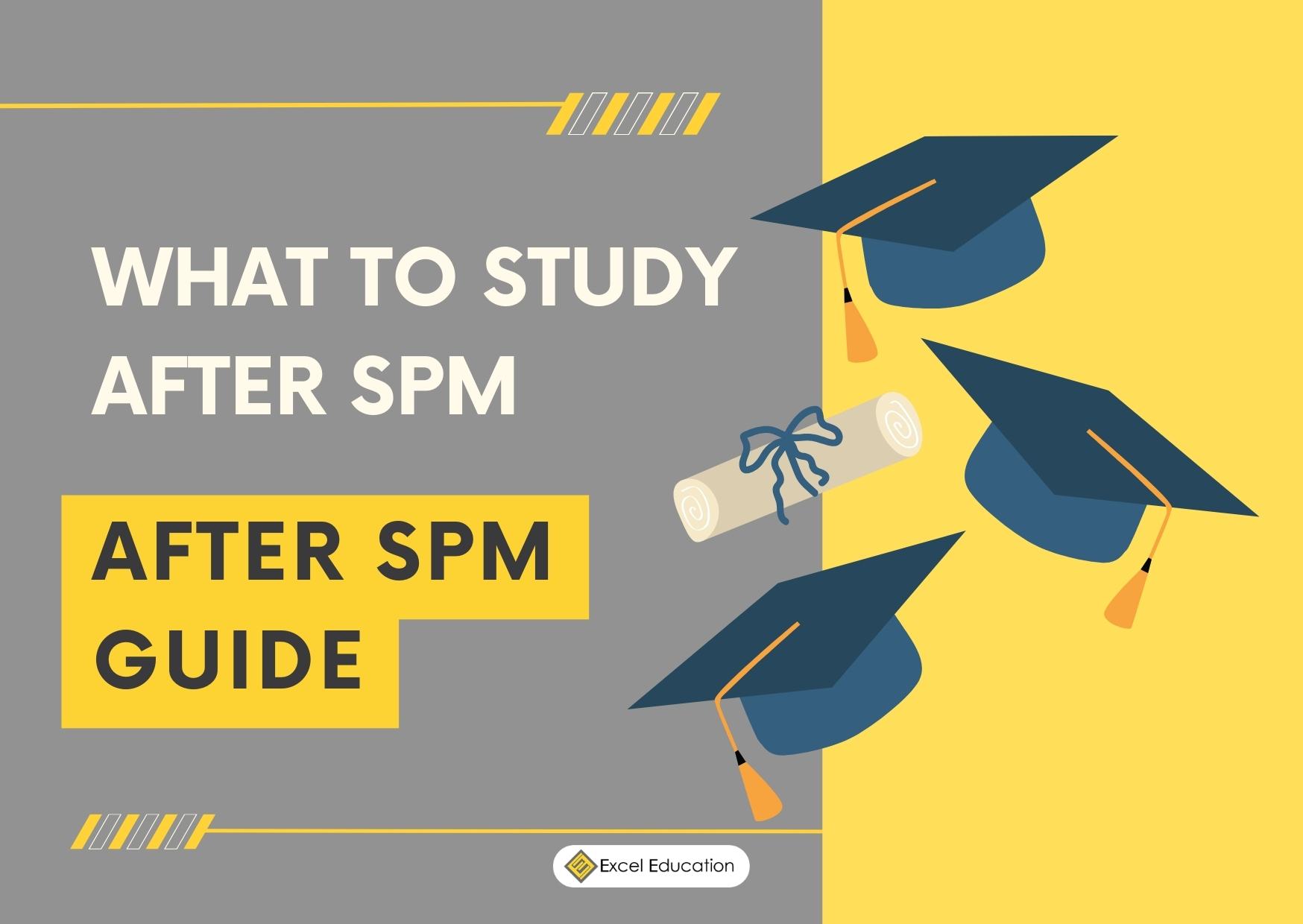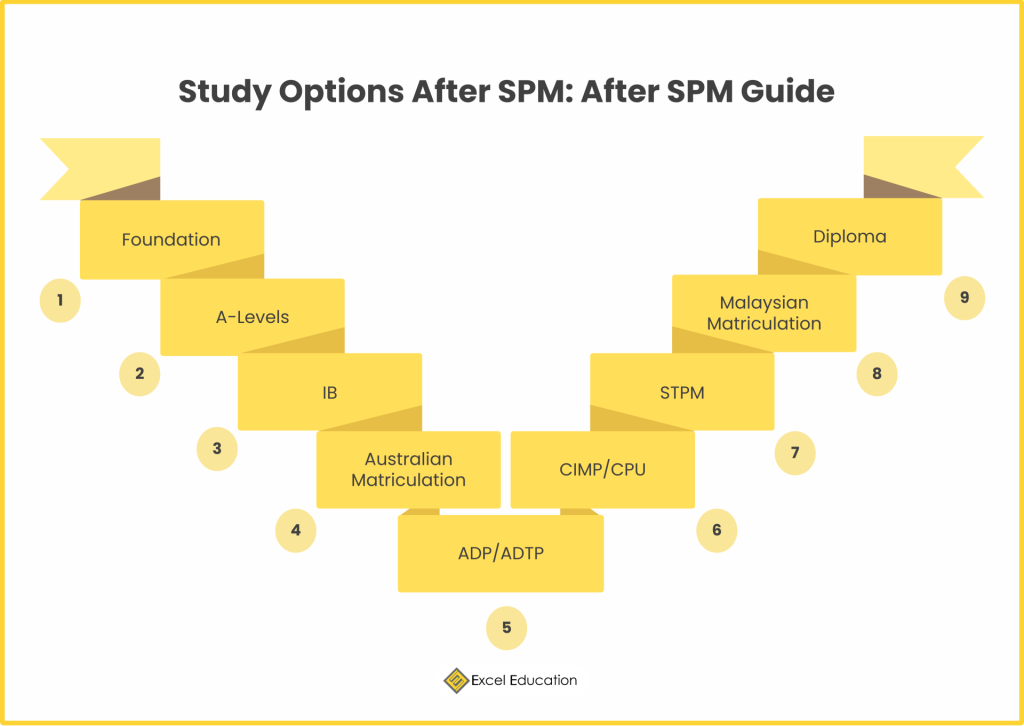
It’s completely normal to be worried and undecided about the future, especially after completing your SPM. What’s important is to utilise the myriad of career and personality tests online to find out your own interests and options before taking this huge step! Otherwise, keep in mind that it’s not the end of the world because what’s important is the journey, not the destination.
Some of the benefits of pursuing tertiary education includes participating in a community which fosters intellectual discussion and inspiration, networking opportunities, and the exposure to multiple beneficial events and projects as well as the opportunity to lead these initiatives as a way of learning transferable and employable skills.
If you’re wondering what to do after SPM, specifically which pre-university programme to enrol in or What to study after SPM, here’s your After-SPM Guide from us!

1. Foundation
Duration: 1 Year
Assessment: Combination of continuous & summative assessments
Foundation programmes are typically a one-year pre-university programme, with a three-semester curriculum. Foundation programmes are generally known as the shortest pre-university programme meant to prepare students who have completed their SPM or equivalent examinations to transition for life in university. Also, the assessments for Foundation programmes generally involve a combination of continuous and summative assessments.
Through a Foundation programme, you can gain basic knowledge of the undergraduate degree you plan on pursuing. Some of the Foundation programmes can act as a direct entryway to an undergraduate degree of your choice. However, more often than not, Foundation programmes are not recognised if you want to pursue your undergraduate degree overseas.
Due to the nature of Foundation programmes where some are broad, such as Foundation in Science and Foundation in Arts, you still have the choice to explore and contemplate your options, whether it relates to the study area or the study level. This might not apply for more restricted Foundation programmes. So, a clear career pathway might benefit you in selection of which Foundation programme to enrol in.
To further delve into understanding Foundation Programmes, you can read our article here.
Contact us right now for a free consultation if you’d like more details about the costs, the format of the programme, and the entry requirements!
2. A-Levels
Duration: 18-24 Months
Assessment: 100% Examinations
A-levels, short for Advanced Levels qualifications, is a UK-based qualification and an internationally recognised programme with a typical duration of 18-24 months. The assessment style for A-Levels are completely based on examinations. So, if you are someone who prefers examinations instead of coursework-styled assessments, you can consider taking up A-Levels as your pre-university programme.
A-Levels in Malaysia have two represented examination boards, namely by Cambridge or by Edexcel. The main difference between the two is that the Cambridge A-Levels programme is linear-based whereas the Edexcel A-Level programme allows for students to retake an exam based on units instead of stages.
Through the A-Level programme, you will delve into a greater depth of particular subject matters and develop valuable skills such as critical thinking, problem solving, research, and writing. A-Level might be a more versatile choice compared to Foundation programmes if you want to pursue an overseas undergraduate degree. However, to qualify into a university or the undergraduate degree, you have to consider the combination of A-Level subjects required by them.
To further delve into understanding the A-Level Programmes, you can read our article here.
Contact us right now for a free consultation if you’d like more details about the costs, the format of the programme, and the entry requirements!
3. International Baccalaureate (IB)
Duration: 2 Years
Assessment: External examinations & Internal tasks
The International Baccalaureate (IB) is an internationally recognised preparatory programme with a typical duration of two years. The evaluation for students under an IB programme is conducted through a variety of assessments including externally assessed examinations and internally assessed tasks including written assignments, oral interviews, fieldwork projects, scientific and mathematical investigations, and artistic performances.
Through the IB programme, students will experience a curriculum which has a workload that encourages and forces them into good habits, resulting in well-rounded students with strong academic, social, and emotional attributes. The IB programme usually implements six core subjects including Language and Literature, Language Acquisition, Individuals and Societies, Sciences, Mathematics, and Arts along with a framework that involves Theory of Knowledge (TOK), Creativity, Action, Service (CAS), and Extended Essays.
If you’re looking for a course which doesn’t confine you to one study area and permits for academic pursuits abroad, then you can consider the IB programme. One thing to note is that the programme is arguably more challenging than an A-Levels programme.
To further delve into understanding the A-Level Programmes, you can read our article here.
Contact us right now for a free consultation if you’d like more details about the costs, the format of the programme, and the entry requirements!
4. Australian Matriculation
Duration: 9-18 Months
Assessment: Coursework & Examinations
Australian Matriculation is a preparatory programme before pursuing an undergraduate degree with a typical duration of 9-18 months depending on the type of Australian Matriculation. There’s two types of Australian Matriculation and they are: South Australian Matriculation (SACE), previously SAM, and the Australian Matriculation (AUSMAT), or the Western Australian Certification of Education (WACE). It is more suitable for those looking to pursue their degrees in Australia. Nonetheless, both Australian Matriculations are not only limited to Australia, they are also recognised by many international and private Malaysian institutions.
In terms of their structure, they contrast from the A-Level programmes because Australian Matriculation does not solely base their assessments on examinations. Instead, the South Australian Matriculation (SACE) implements a 70% coursework with 30% examinations and the Australian Matriculation (AUSMAT) implements an equally divided structure, with 50% coursework and 50% examinations.
Australian Matriculation allows students to take up to five subjects with different flexible combinations. In turn, there still leaves a room for more contemplation and a wide range of options for undergraduate academic pursuits.
To further delve into understanding the Australian Matriculation programmes, you can read our article here.
Contact us right now for a free consultation if you’d like more details about the costs, the format of the programme, and the entry requirements!
5. American Degree Programme (ADP/ADTP)
Duration: 3-4 Years
Assessment: Coursework & Final Exam
American Degree Programme (ADP) or American Degree Transfer Programme (ADTP) are programmes which allow for transfers into overseas universities or to study in Malaysia with an award from an overseas institution. The programme is mainly for North America but some institutions also offer the programme in other countries. For instance, Methodist College Kuala Lumpur (MCKL) has ADTP to Handong Global University, South Korea.
Most of the ADP or ADTP programmes have a duration of three to four years, where you are able to enrol after your SPM or equivalent examinations. These programmes usually offer duration structures which are presented as 1+3 or 1.5+2.5 or 2+2 Years. If it’s a 2+2 programme, then you would spend two years in Malaysia and two years abroad. In a way, this programme is cheaper than having to spend a full four-year degree abroad.
The ADTP and ADP programmes have a myriad of options for study based on your academic and professional interests. As such, it is important for you to read up to make an informed decision. Assessments for the programmes would depend on the university or the course itself but it generally employs a curriculum with 70% coursework and 30% final exam.
To further delve into understanding the Australian Matriculation programmes, you can read our article here or this article to understand transfer and twinning programmes..
Contact us right now for a free consultation if you’d like more details about the costs, the format of the programme, and the entry requirements!
6. Canadian International Matriculation Programme (CIMP) & Canadian Pre-University (CPU)
Duration: 1 Year
Assessment: Coursework & Examinations
The Canadian International Matriculation (CIMP) and Canadian Pre-University Programme (CPU) are internationally recognised preparatory courses originating from Canada, and completion of the programmes will permit an Ontario Secondary School Diploma (OSSD) score. Some might equate the CIMP and CPU programmes with the final year of high school in Canada.
The Canadian International Matriculation and Canadian Pre-University Programme will generally take up a one year study duration and other times a fifteen months. The CIMP and CPU programmes grant students to take up a combination of six or seven subjects depending on the future academic or professional pursuits students are aiming for. The programmes employs a structure with a division of 70% coursework and 30% examinations.
The CIMP and CPU programmes are suited for you if you’re looking to study abroad, particularly but not limited to Canada, and if you are more keen with a holistic approach to learning without heavily exam-based assessments. The grading system of the CIMP and CPU programmes are based on the Ontario Rubric with quality assurance set by the Ontario Ministry of Education, Canada.
For more information on the Canadian International Matriculation and the Canadian Pre-University Programme, reach out to us!
7. Sijil Tinggi Persekolahan Malaysia (STPM)
Duration: 18 Months
Assessment: School-based Assessments & Final Examinations
Sijil Tinggi Persekolahan Malaysia (STPM), also known as Form 6 in Malaysia, is a programme spanning over a study duration of 18 months with one annual intake. STPM is one of Malaysia’s federal examinations with wide international recognition from universities abroad. The recognition of the STPM programme is arguably on par with the recognition of the A-Level programme.
STPM is subsidised by the Malaysian government and classes are mostly conducted in government schools, making STPM an affordable pre-university programme option. The STPM programme offers two broad study streams, Social Science and Science, allowing students to explore various subjects before specialising in a specific field at university level.
STPM is structured with a format with combined school-based assessments and final examinations divided into weightage of 20-40% and 60-80% respectively. If you want a programme which is cost-effective, internationally recognised, without narrowing your academic and professional pathways, then STPM might be a good option to consider.
To further delve into understanding the STPM programmes, you can read our article here.
Contact us right now for a free consultation if you’d like more details about the costs, the format of the programme, and the entry requirements!
8. Malaysian Matriculation
Duration: 12 or 24 Months
Assessment: Continuous Assessments, Summative Examinations, Final Examinations
The Malaysian Matriculation programme or Matrikulasi is one of the other Malaysian pre-university programme options. The duration of the programme depends on which route you choose. You have the option of doing the programme for 12 months (two semester system, or Program Satu Tahun, PST) or 24 months (four semester system, or Program Dua Tahun, PDT). The Matrikulasi programme is widely recognised in local Malaysian universities and certain foreign universities as well.
The Matrikulasi programme is considered an affordable pre-university option where students have the option to enrol in one of the four streams, which are the Science stream, the Accounting stream, the Professional Accounting stream, and the Engineering stream.
Students enrolled in the Matrikulasi programme will be assessed based on continuous assessments, summative examinations, and Peperiksaan Semester Program Matrikulasi (PSPM), which can generally be understood as a final semester examination of the programme.
However, one significant feature of the Matrikulasi programme is that it has a reserved quota for student admissions.
For more information on the Malaysian Matriculation programme, reach out to us!
Contact us right now for a free consultation if you’d like more details about the costs, the format of the programme, and the entry requirements!
9. Diploma
Duration: 2-3 Years
Assessment: Combination of Coursework & Final Examinations
A Diploma is an option to consider if you are looking to continue studying after your SPM. How does a Diploma differ from a degree? Or how does a Diploma differ from pre-university programmes? A Diploma is known to be a preliminary academic degree which has a higher qualification than a Foundation programme but one level below of a complete undergraduate degree. Some might equate a Diploma to the first year of an undergraduate degree.
A Diploma might have a typical duration of two to three years. Most Diploma programmes employ a syllabus which emphasise practical and technical skills alongside theoretical knowledge. Additionally, most Diploma programmes would have attached internships within their course design. Assessments in Diploma programmes are a combination of coursework and final examinations.
A winning factor of Diploma programmes is that it enables employment after completion of the programme. Also, if you are planning to continue to an undergraduate degree, you might be able to directly enter Year 2 of an undergraduate degree.
To further delve into understanding Diploma programmes, you can read our article here.
Contact us right now for a free consultation if you’d like more details about the costs, the format of the programme, and the entry requirements!
For more information regarding the programmes to study after SPM, universities, entry requirements and fees, contact Excel Education.
About The Author

Hannah Hir
Hannah appreciates various art forms, especially Asian literature, film and music. Most of her favorite Malaysian kuihs are green-coloured.

